Introduction
Nowadays, Information and Communication Technologies (ICTs) have become important tools in many areas of society (Bobkina & Fernandez de Caleya, 2011; Lin & Atkin, 2014; Ricalde, Hernández, & Luna, 2013). An example of these technologies is the internet, which is undoubtedly part of our lives, and its influence is likely to continue and increase in the future. In the case of education, the internet provides unlimited resources for teachers (Hjalmarsson, 2015). Within the field of Foreign Language Teaching (FLT), the use of internet has also experienced an exponential growth (Barnawi, 2009; Hjalmarsson, 2015; Saadat & Hussin, 2013), and it is used for multiple purposes, such as providing access to different types of accents or authentic materials, chatting with native speakers of the target language or other learners, and searching for information on the internet (Ramirez, Cadena, Araiza, & Aguilar, 2006). Nevertheless, it is well known that not all information found on the internet is reliable and useful for FLT and learning, and many gaps still exist within FLT in regard to internet use. Therefore, better developed resources or activities are needed to help students and teachers.
One of these resources or activities are WebQuests, which have been in the educational sector for over twenty years, and successfully used within the field of FLT for a similar number of years (Alshumaimeri & Almasri, 2012; Arsanjani & Faghih, 2015; Irzawati & Asiah, 2013; Tuan, 2011).However, due to the emergence of new technological applications, in recent years, WebQuests seem to have been left behind, especially because their format and visual display have not really changed in those two decades. In this article, we will demonstrate that WebQuests still can be a valuable tool for EFL teaching if their appearances become more attractive and they are enhanced with more interactive tools and gadgets by using website generators such as Wix.com instead of more traditional Webquest generators. For that purpose, we will discuss the design and implementation of a Webquest aimed to help EFL Mexican high school students to improve their pronunciation and fluency skills that was developed with Wix.com and the results we were able to achieve.
What is a Webquest?
WebQuests were introduced by Bernie Dodge and Tom March from San Diego State University in 1995. According to Dodge (2002), a WebQuest is an inquiry-oriented activity that requires learners to use the web in order to find information about a specific subject. WebQuests were created to help students use time wisely, to focus on using information rather than searching for it, and to develop their thinking skills and levels of analysis, synthesis and evaluation (Dodge, 2002). WebQuests were designed based on the ideas of constructivism, which conceptualizes learning as “an active process of constructing rather than acquiring knowledge” (Duffy & Cunningham, 1996, p. 171), and more specifically on two constructivist ideas: “(1) Piaget’s cognitive constructivism, demanding inquiry method of teaching (Piaget, 1973) and (2) Vygotsky’s social constructivism with its emphasis on the theory of social interaction and the Zone of Proximal Development” (Vygotsky, 1978, as cited in Kachina, 2012, p. 186). From this perspective, WebQuests can be used to promote cooperative learning where group members become experts in their roles and contribute to the full understanding of the final group task, and as a scaffold for instruction (Irzawati & Asiah, 2013; Tuan, 2011). Dodge (1997, para. 4) states that a well-designed WebQuest should have the following sections:
- Introduction: an overview of the activity and some background information.
- Task: the description of the central activity that students have to perform.
- Information sources: a descriptive list of useful resources for doing the activity, such as websites, web documents, databases, etc.
- Description of process: the steps needed to accomplish the task.
- Guidance: the tools intended to help students on organizing the information they are internalizing, such as concept maps, timelines, guiding questions, etc.
- Conclusion: a summary of what students should have learned after completing the task and encouragement to further explore the topic.
Literature Review
Evolution of WebQuests
For Adell, Mengual-Andrés & Roig-Vila (2015), WebQuests were one of the first didactically supported proposals that took advantage of the resources offered by the internet during the 90s, and by doing so, “facilitated the introduction of technological literacy into the classroom” (Kachina, 2012, p.186). In addition, Webquests introduced a new set of student-centered activities that helped the transformation of a teacher-centered education into a student-centered one (Adell, et al., 2015).
In the past two decades, WebQuests have been part of the educational sector. They have experienced several changes, such as the renaming of some of their components, the reorganization of their sequence, the increasing of the complexity of the thinking skills required for their completion, and the addition of constructivist strategies such as cooperative and scaffolding activities (Abbit & Ophus, 2008; Adell, et al., 2015; Kachina, 2012).
Changes have been triggered by several factors. First of all, Dodge (2002) made some modifications to his original proposal, by renaming of parts, changing sequences, and adding constructivist strategies. The evolution of technology has also been a key factor for changes of Webquest: the rise of Web 2.0, the emergence of a vast number of free online applications, and the boom of social networks that offer teachers new possibilities to work with. A third factor has been the popularization of WebQuests in different areas of knowledge and educational levels as well as contexts (Abbit & Ophus, 2008; Adell, et al., 2015)
However, despite these changes and the emergence of new online tools, the format and visual display of WebQuests have not really changed much over the years mainly because those features relied heavily on basic html websites and WebQuests generators such as Questgarden or Teachnology’s Generator, that were easy to use but had a limited number of applications. The problem then became that WebQuests began to look dull and unappealing, to the point that they were no longer attractive for new generations of more technology-savvy students.
WebQuests in Teaching English as a Foreign Language
In the field of FLT, WebQuests can be used to help students develop different foreign language skills (Alshumaimeri & Almasri, 2012). Ramirez et al. (2006) mention that listening and speaking skills can be addressed in WebQuests by assigning students to work with different English accents and forms of expression, and by asking them to present their findings in an oral or written form. The authors also claim that WebQuests can be used to address reading and writing skills in order to teach students how to search information in different web sources. Moreover, Ramirez et al. (2006) state that WebQuests are powerful motivation instruments for students, because the students usually feel more attracted to working with authentic language found on the internet rather than working with traditional materials.
Several studies that support the previous statements have been carried out in the field of English Language Teaching. In the following, we present those found in the available literature related to the use of WebQuests to teach a specific skill to EFL students.
In their study with Iranian intermediate EFL students, Arsanjani and Faghih (2015) inquired about the effectiveness of WebQuests on improving learners’ writing performance. The participants were divided into two groups of sixteen members. One group received writing instruction based upon WebQuest activities, and the other group received traditional classroom writing instruction. Both groups of students had to take a writing test at the beginning and at the end of the study. The group that was taught using WebQuest activities obtained higher results in the post test than the group that received traditional writing instruction. According to the authors, these results showed that WebQuest instruction had a greater impact on learners’ writing performance than traditional classroom instruction. The authors concluded that “WebQuests offered good internet based language learning opportunities because they provide learners with exposure to authentic materials, and possibilities for real communication in the target language” (Arsanjani and Faghih, pp. 44-45).
In another study, Irzawati and Asiah (2013) explored students’ perceptions concerning the use of WebQuests to support learning grammar in higher education. The participants were seventy-two Information System and Technical Information undergraduate students of a university in Palembang (Indonesia). These students were taking an English course for TOEFL (Test of English as a Foreign Language) preparation. The course was held for nine meetings, and three of these meetings dealt with grammar. The teacher provided a WebQuest to the students designed by her and the researcher to help them study grammar. Questionnaires and interviews were administered to the students after the experience was completed. The results showed that “students of higher education have good perceptions toward the use of WebQuest for supporting learning grammar” (Irzawati & Asiah, 2013, p. 18). According to the results from the participants’ questionnaires and interviews, WebQuests were found to be beneficial, interesting, enjoyable, and encouraging in the learning of grammar.
Alshumaimeri and Almasri (2012) investigated about how WebQuests influence EFL students’ reading comprehension performance. The participants were eighty-three male undergraduate students from science and engineering fields from King Saud University (Saudi Arabia). The participants were divided into two groups: 42 in an experimental group and 41 in a control group. The control group received traditional instruction in reading comprehension, and the experimental group received traditional instruction plus researcher-designed WebQuests supplementary materials. The results of the pre-tests and post-tests showed that the use of WebQuests as supplementary materials promotes better reading comprehension than those only using traditional methods; this could be observed because the experimental group showed higher post-test scores than the control group (Alshumaimeri & Almasri, 2012).
Finally, Gonzalez (2009) explored the importance and advantages of using WebQuests with children who are learning English in the Mexican school setting. A WebQuest was designed to teach vocabulary and grammar of a specific unit from the course she taught. The students presented their results in class, and the author reports that it was a successful activity, because students were motivated and engaged in it. Gonzalez (2009) concludes that using WebQuest to teach English to children is an effective way of promoting autonomy, catching their attention, and helping them to work with enthusiasm. The previous studies have contributed to a greater understanding of the use of WebQuest in the field of EFL. However, no papers were found that addressed the use of WebQuests to help students to improve their pronunciation and speaking skills in the context of Mexico. Our project sought to address that gap by designing a WebQuest aimed to help EFL high school Mexican students to improve their pronunciation and fluency skills, using a website generator that allowed us to create a more meaningful, attractive, and interactive activity than those created using traditional WebQuests generators.
Context
The project was conducted with a fifth semester group of students from a private high school in Hermosillo, Mexico. The class consisted of twenty-eight students: seventeen females and eleven males who were taking a phonetics and phonology course. The students were a combination of intermediate and advanced EFL learners whose native language was Spanish, and whose final project was to finish a WebQuest.
Methodology
The WebQuest had to be completed in teams of four people. The teams had a balanced mixture of intermediate and advanced students. This mixture was selected in order to obtain the best of collaboration. The students were graded based on the rubric provided in the evaluation section of the WebQuest (see Appendix 1). It was worth a total of twenty points (the value of the project for that partial) and it was divided into five sections worth a maximum of four points each.
The WebQuest lasted one month and the students had to turn in a section of the project each week. All the activities and communication for the project were done online and the students communicated with the teacher via e-mail and sometimes through private messaging of Facebook. At the end of the project, the final product was uploaded to YouTube and the link to the video was sent to the instructor.
The video was evaluated by the teacher who compared the data related to students’ pronunciation of a set of sounds of English with similar data that he had collected at the beginning of the semester. For the evaluation he employed a checklist (see Appendix 2) of the consonant and vowel sounds on American English.
Design
In our project we sought to overcome the design and formatting problems already mentioned in the introduction and the literature review section. For that purpose, we decided to create a WebQuest that took into consideration Dodge’s standards (1997) while having a more attractive and dynamic design to foster motivation and engagement from the students. After all, using material which is authentic and attractive is thought to improve motivation (Dörnyei, 1994).
To achieve that goal, we decided to use the website generator Wix.com©. We considered it a better option since it had a wider array of templates and gave way to the inclusion of multimedia and gadgets, such as dictionary plug-ins, moving picture galleries, direct contact forms, direct video embedding, and personalized background display.
Additionally, Wix.com© allowed us to create a more appealing design for our content. Our WebQuest followed the structure suggested by Dodge (1997) and asked students to act as speech therapists and English teachers in order to help Spanish speakers with the most common pronunciation mistakes. They worked in teams and they had to carry out the following activities:
- Identify the most common pronunciation mistakes by Spanish speakers
- Investigate and formulate possible solutions for those problems
- Look for and/or design activities to implement the solutions
- Elaborate a video tutorial explaining and showing the different activities
In the following paragraphs we explain the sections a WebQuest should have according to Dodge (1997), and describe how we created each one of them as well and how they finally looked.
Presentation
The first section of a WebQuest should be the presentation page (Dodge, 1997). In this section the students are presented with a welcome screen to the project which can be combined with the introduction section of the WebQuest. In the following illustration, the typical structure of a WebQuest introduction made with a WebQuest generator, such as Questgarden.com, can be appreciated.
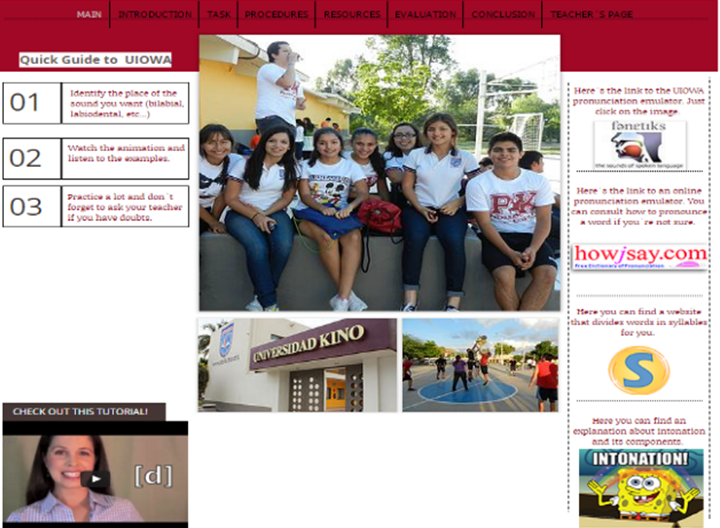
Illustration 1. Introduction of a WebQuest created with Questgarden © (authors’ creation).
Thus, WebQuest generators, such as Questgarden.com, only allow for the inclusion of images and texts of varying color. During the 1990s and early 2000s such websites were acceptable because that was what technology could offer at the time. Nonetheless, in today’s era of information technologies, such websites can only be shunned by younger generations. In contrast, an introduction page from a WebQuest in Wix.com has the potential of looking the following way:
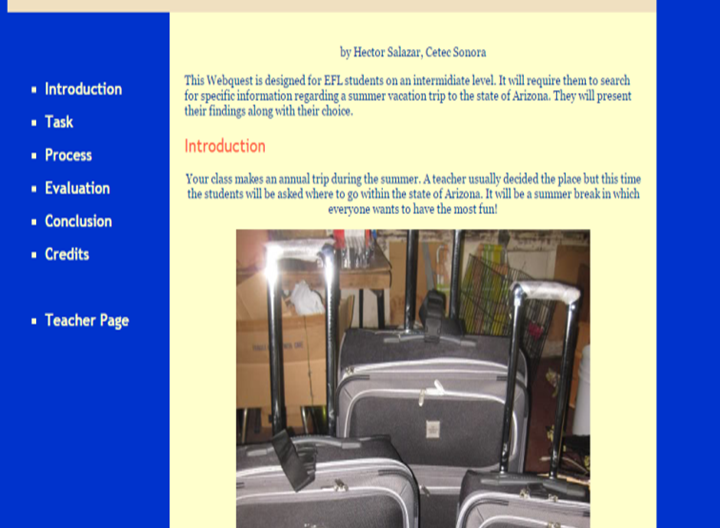
Illustration 2. The main page of a WebQuest created withWix.com (authors’ creation).
Illustration 2 above shows our main page, which not only contains text and images, but interactive flash buttons, a moving image gallery, and an embedded video. Additionally, in the introduction section, we included the roles of the participants, the objectives of the WebQuest, as well as an overview of what they had to do during the project, as shown in the following illustration:
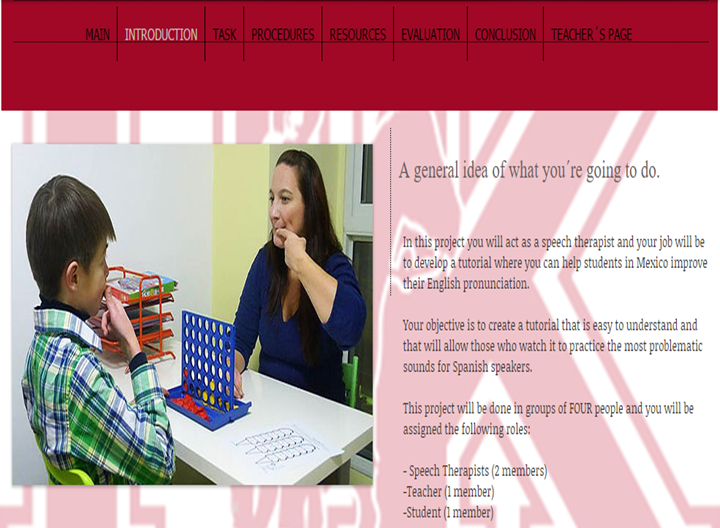
Illustration 3. Introduction page of our WebQuest in Wix.com (authors’creation).
Task
In this section the students were told what their specific roles were and the deadline for the assignment. They were also asked to work as researchers, teachers, and students in order to create a video tutorial that helped Mexican English learners to improve their pronunciation in English and to provide them with some aid which would help them deal with typical pronunciation problems that Spanish speakers face when learning English. This section of the WebQuest was designed with a simple layout and with little information about the activities because they were explained in the procedures section. This section was enhanced with a flash photo gallery and an interactive banner as shown in Illustration 4 below.
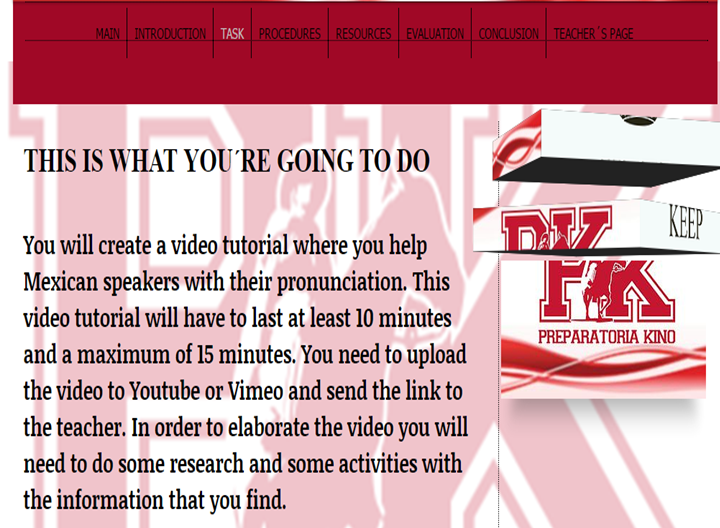
Illustration 4. Task Section of our WebQuest created in Wix.com (author’s creation).
Procedure
This section of the WebQuest described the procedures students followed to accomplish the task. We paid special focus to make sure that the instructions were clear and understandable, but some mishaps still occurred, such as students trying to turn in assignments in person instead of electronically, as well as trying to use Facebook instead of e-mail, and using file formats which were not the ones asked for in the instructions. Nonetheless, the majority of the students were able to follow the instructions properly. This section was enhanced with a direct contact form so that students could formulate their doubts and get feedback immediately, as shown in Illustration 5.
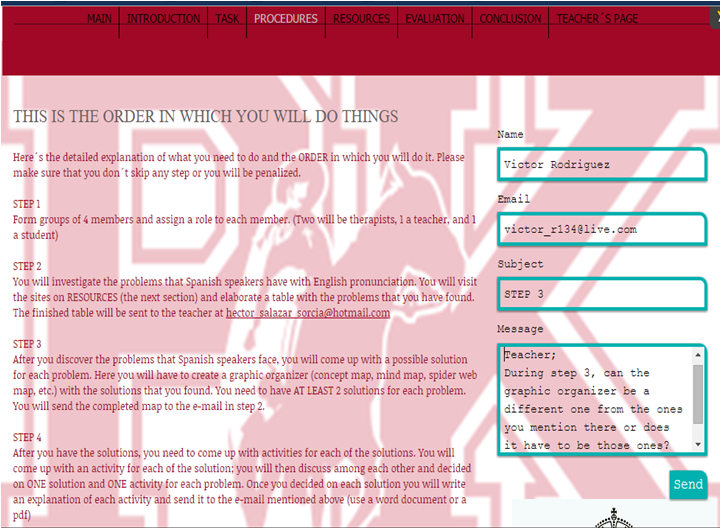
Illustration 5. Direct contact form embedded in the procedures section (authors’ creation).
Resources
The resources section is where students received information needed to complete the project. In our case, this section did not differ from a traditional WebQuest since it did not require many elements. The hyperlinks to the websites were available here, as well as a brief description of the information available in those sites. Illustration 6 provides the reader with these resources below.
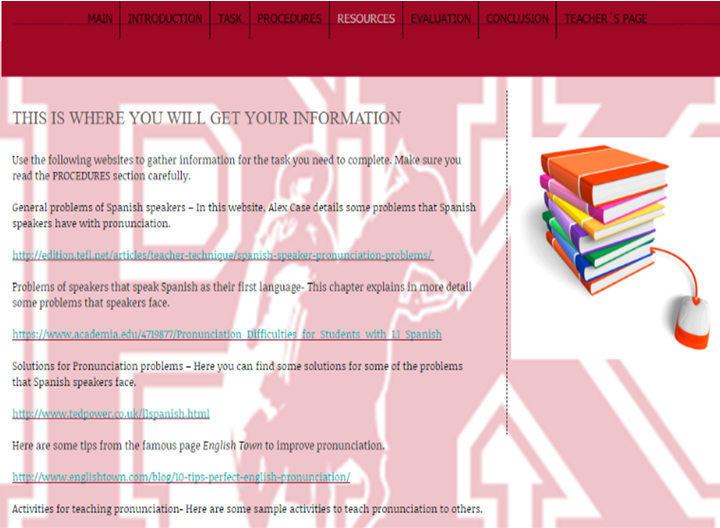
Illustration 6. Resources section of our WebQuest (authors’creation).
Evaluation
The evaluation section of a WebQuest is crucial and it should be specific and detailed. There are several ways to go about this, and for our WebQuest a rubric was used. The rubric amounted to a total of twenty points (which is the worth of the project in each partial) and consisted of five categories. The rubric and its specifications (see Appendix 2 at the end of the article) graded the following aspects: the amount of problems found, the solutions implemented, the activities for each solution, the script of their tutorial, and their tutorial video. The first concerning the amount of problems checked the students’ research abilities, while the second aspect (solutions implemented) looked at the students’ creativity. The third aspect of activities implemented dealt with the students’ resourcefulness and problem-solving abilities. The fourth aspect (their script) checked their organization and the final (their tutorial) was concerned with their fluency and pronunciation.
Concluding Section
The final section of a WebQuest is a general wrap-up of the project. It contains some final remarks for the students. In this section, we summarized what students should have learned and offered some final suggestions to the students, as shown in Illustration 7.
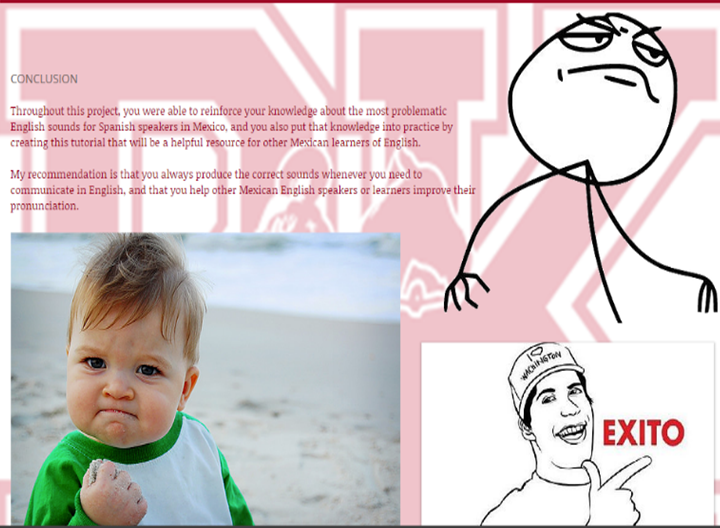
Illustration 7. Conclusion of our WebQuest (authors’creation).
Teacher’s Page
This page is for the teachers and it is not meant to be seen by students. In this section, the creators of the WebQuest must explain the WebQuest so that other teachers understand the pedagogical approach behind it, and provide detailed information that allows others to replicate it if they wish to do so. This page may be concise or thoroughly detailed, but regardless of the choice it is a good idea to leave contact info from the creator(s).
In our particular case, we explained that the WebQuest was meant for fifth semester of high school students and that it was carried out in a private institution. We also specified that the students taking part in the project needed to have a Common European Framework (CEF) B1 level at least in order to properly carry out the activities. According to the Common European Framework of Reference (Council of Europe, 2016), a B1 user is able to have the following abilities:
Can understand the main points of clear standard input on familiar matters, regularly encountered in work, school, leisure, etc. Can deal with most situations likely to arise whilst travelling in an area where the language is spoken. Can produce simple connected text on topics which are familiar or of personal interest. Can describe experiences and events, dreams, hopes and ambitions and briefly give reasons and explanations for opinions and plans. (p. 24)
Finally, we explained that in order to be carried out in a different academic level some adjustments would be necessary. Illustration 8 shows the teacher’s page below.
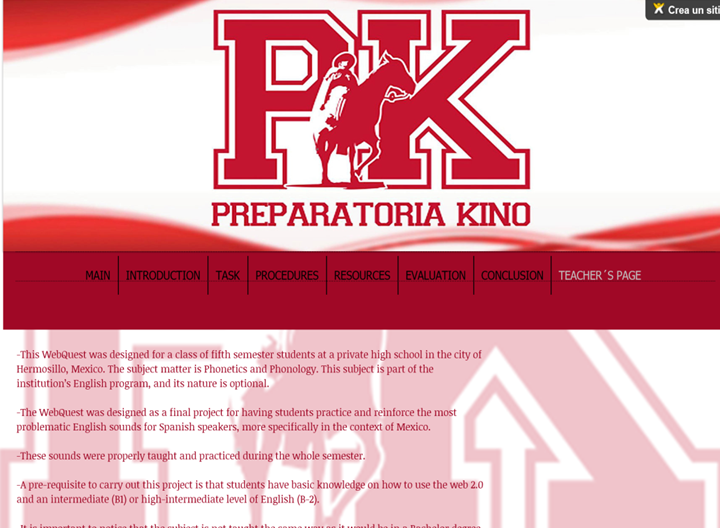
Illustration 8. Teacher’s page (authors’ creation).
Presentation and Discussion of Results
As we already mentioned, we sought to design a WebQuest to help EFL Mexican high school students to improve their pronunciation and fluency skills by using a website generator which allowed us to create a more meaningful, attractive, and interactive activity than those created using traditional WebQuests generators. In this section, we present the results in two parts: 1) the advantages we found by using a website generator instead of a traditional WebQuest generator and 2) our students’ learning and the impact that this had.
In regard to the generators, we found that the use of website generators resulted more advantageous than traditional WebQuest creators. Websites generators allowed us to include more and better features in the WebQuest. The advantages of using a newer website creator like Wix.com over a traditional generator like Questgarden are summarized in Table 1.
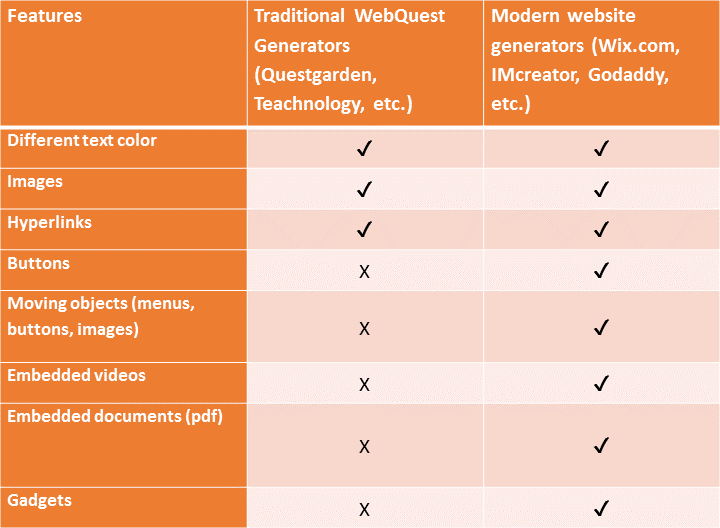
Table 1. WebQuest features: traditional vs. modern generators.
As shown in Table 1, older WebQuest generators can only offer basic features. Once again, this is understandable because they were introduced when those features were the only options available. The additional features have become an expectation mostly due to the rapid advancements in technology. The features mentioned above are present in any blog, LMS platform, or social network available nowadays. Technology is already ingrained in many aspects of society and not including it in the classroom of younger learners creates a contrast to the society in which they live. In the case of Mexico, according to the National Institute of Statistics and Geography (Instituto Nacional de Estadística y Geografía/INEGI) 85.9% percent of Mexico’s teens between the ages of 12 and 17 use the internet (INEGI, 2016), thus it is only normal that they will not find activities or materials that do not match the technological standards of their current generation appealing. The websites they have been exposed to since their first contact with the web contain far more features than the ones offered by WebQuests elaborated with traditional WebQuest Generators
In relation to our students’ learning associated to their experiences with the WebQuest, the data analysis seems to suggest that such experiences rendered results not only in students’ pronunciation and fluency skills, but also in their ability to research. Additionally, it triggered their creativity, problem-solving skills, and the ability to work with others.
Regardingour students’ learning related to their pronunciation and fluency skills, we found that students showed better results after working with the WebQuest than those they had at the beginning of the activity. The majority of the students were already fluent speakers of English, but they still struggled with certain sounds such as /ɪ/, /v/, and /θ/. After completing the activities of the WebQuest, students showed better articulation especially of the /v/ and /θ/ sounds. Moreover, 26 out of 28 students who participated in the project improved their pronunciation of the /v/ sound and 23 out of 28 students showed improvement when pronouncing the theta sound.
In addition, during the first stage of the activity, some students tended to just copy and paste from the websites offered in the resources sections, so the teacher had to provide them with additional guidance by showing them how to retrieve information from a website and then cite (using the APA style) where the information was obtained. This gave us evidence that even though the students had the abilities to use the technology for searching, they lacked the ability to research properly. Many students considered that research was to go to a website and copy the information in it. They did not check what the information was about, or whether all the information given was necessary for the assignment at hand. However, during the second activity there were fewer times in which this occurred, and by the third activity, students showed a considerable improvement in the quality of their assignments. Students began to use proper citations using the APA style (with the help of online resources such as Purdue Owl), and some students showed remarkable progress, since they not only used direct citation, but they used paraphrasing as well. Additionally, they began to include a reference section at the end of their assignments. Finally, the quality of their sources increased, since they steered away from sites that did not include an author or publication date.
The WebQuest also helped students to further develop their creativity, especially in the elaboration of their own activities and that of the final video. For instance, one of the teams structured their tutorial as a fairy tale in which the protagonist would transform herself by improving her pronunciation in English. Among the solutions, these students came up with were tips for better pronunciation and games to help students relax and thus be able to speak better. Illustration 9 below shows some of the activities carried out by this group of students.
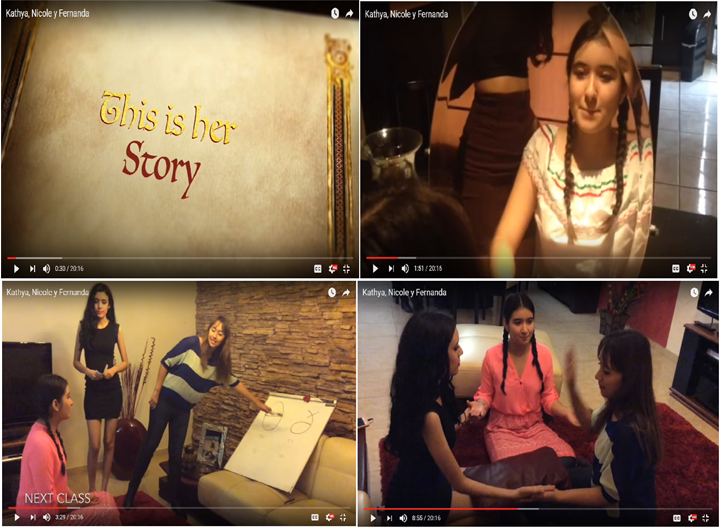
Illustration 9. Tips and games to improve pronunciation.
Additionally, the students showed creative and innovative solutions to the problems they encountered. Giving them a wide arrange of problems to solve required them to think outside the box and some showed great results. For example, some students gave tips and developed activities to help fellow learners practice and improve their pronunciation, such as when they tried to explain the back vowel sound of /o/, they suggested forming a circle with their mouths. They also recommended that students monitor the amount of content and function words in a sentence to determine stress. Illustration 10 below shows an example of solutions proposed by one of the groups:
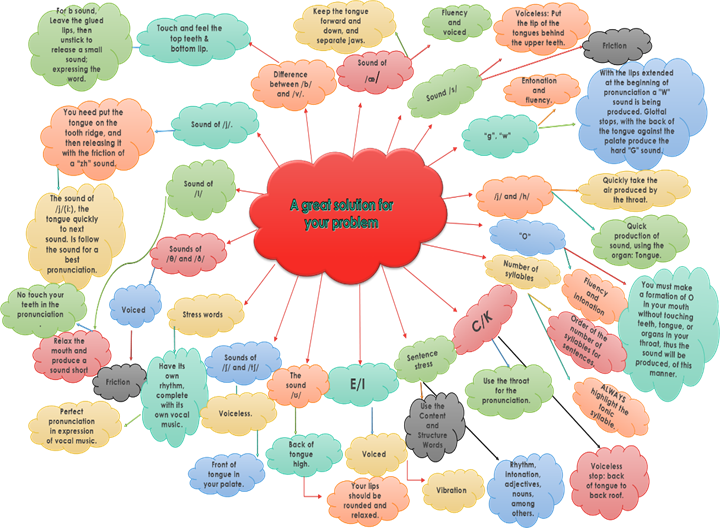
llustration 10. Students’ mind map for solutions.
Finally, the WebQuest also required students to work collaboratively, and this yielded positive results in regard to improving their teamwork-related abilities: Students who were reluctant to work together had to manage to overcome their differences to create products, to the point that most of them began to interact more during class. Furthermore, the nature of the project and the amount of work made them organize and assign responsibilities to the different team members, in such a way that the individual skills of each student supported the team and allowed them to perform better.
Discussion of Results
Based on our experience, we conclude that the range of personalization in a site such as Wix.com is far broader than that of a WebQuest generator because the former was made to comply with the new trends in website creation. Website generators offer more than traditional WebQuest creators and sites, Wix.com provides educators with an appealing and attractive way to create WebQuests without the need of advanced technological knowledge. In regard to the promotion of skills, such as creativity and problem-solving, a WebQuest created with a traditional WebQuest creator could be just as effective as one created with a website generator, but it would be hindered by the lack of visual appeal and interaction features offered by WebQuests made with website generators.
In relation to our students’ learning associated to their experience with the WebQuest, our evaluation provides evidence that such experiences rendered results not only in students’ pronunciation and fluency skills, but helped students to learn how to research, prompted their creativity and their problem-solving skills, and helped them to improve their team-work related abilities. These results, in turn, demonstrate that our idea to create and implement an activity that encourages an active and collaborative process of knowledge construction by students is consistent with Piaget’s cognitive and Vygotsky’s social constructivism. The positive results validated the relevance of aligning instructional design to such theoretical frameworks. Our results also reinforce those found in previous studies and experiences about the positive impacts on students of the use of WebQuest in EFL courses, (Alshumaimeri & Almasri, 2012; Arsanjani & Faghih 2015; Irzawati & Asiah, 2013).
Conclusions
A WebQuest is a great teaching tool and it still has great potential even twenty years after its creation, because it has solid theoretical foundations and it is a great tool to introduce students to group work and autonomous learning, as well as to conduct documental research. The concept of WebQuest has not changed. What has changed is the possibility to improve its appearance to make it more attractive and to provide it with more user-interface interaction.
In this paper, we have tried: (a) to describe and evaluate the design and implementation of a WebQuest in an EFL course created to help Mexican high school students to improve their pronunciation and fluency skills and (b) to demonstrate that a WebQuest developed with a website generator can be used to create more meaningful and attractive WebQuests than those designed with a more traditional one and thus, produce better results with students.
Based on the experience obtained from this project, the following recommendations can be offered:
- Before asking students to work with a WebQuest, the teacher should explain to them what a WebQuest is and its purpose. If possible, the teacher should devote a whole class to explaining it and making sure the instructions are clear and that they can be followed without the need of further clarification from the teacher.
- In order to avoid confusion and to give students a clearer idea about what is expected from them, it is highly recommended to provide a sample of the product desired. This is especially helpful when it is the first time that students work with a WebQuest.
- It is important to provide only relevant websites for students and to check them periodically, to make sure they are still online.
- The evaluation may vary depending on the nature of the project and the specific needs of the course, but a concise criterion is imperative.
- Make sure to ask yourself if the WebQuest looks attractive enough for your students, and preferably have someone their age look at it first.
- In the concluding section, teachers may also include some specific tasks that students should be able to carry out after completing the WebQuest.
- Make sure to include multimedia components. If you are not sure how to do it, ask a colleague for help or look for a solution online
In conclusion, it is important to recognize that the essence and original objectives of WebQuests are to promote collaboration and superior thinking while having fun! WebQuests are still relevant and useful activities. To conclude English teachers just need to adapt their knowledge to the current technological advancements.
Useful Resources
Phonetics WebQuest. [http://hectorazteca7.wixsite.com/phonetics-webquest]
This is the link to the WebQuest referred to in the article.
Wix.com: [http://www.wix.com/]
This useful resource is a website which works as a platform to create websites and it offers templates to help with the creation of websites and hosting of the site.
WixED: [http://www.wix.com/wixed/online-courses?_ga=1.253963720.1725754091.1470245572]
This one offers a free course on website creation on Wix.
How to create a page in Wix.com: [https://www.youtube.com/watch?v=N6OCF23HyT0]
Make a free website with Wix-Free website builder tutorial.
References
Abbit, J., & Ophus, J. (2008). What we know about the Impacts of WebQuests: A review of research. AACE Journal, 16(4), 441-456.
Adell Segura, J., Mengual-Andrés, S., & Roig-Vila, R. (2015). Presentación del Monográfico. WebQuest: 20 años utilizando Internet como recurso para el aula. Edutec. Revista Electrónica de Tecnología Educativa, (52), 1-7. doi: 10.21556/edutec.2004.17.530
Alshumaimeri, Y. A., & Almasri, M. M. (2012). The effects of using WebQuests on reading comprehension performance of Saudi EFL students. Turkish Online Journal of Educational Technology-TOJET, 11(4), 295-306. Retrieved from http://www.tojet.net/articles/v11i4/11429.pdf
Arsanjani, M., & Faghih, E. (2015). The impact of the Webquest instruction system on Iranian intermediate EFL learners’ writing performance and perception. International Journal of Instructional Technology and Distance Learning, 12(2), 37-47. Retrieved from http://itdl.org/Journal/Feb_15/Feb15.pdf
Barnawi, O. Z. (2009). The internet and EFL college instruction: A small-scale study of EFL college teachers’ reactions. International Journal of Instructional Technology and Distance Learning, 6(6), 47-64. Retrieved from http://www.itdl.org/Journal/Jun_09/article04.htm
Bobkina, J., & Fernández de Caleya Dalmau, M. (2012). Blended learning: enseñanza virtual en la asignatura de inglés en las carreras técnicas a través de webquests. RELADA:Revista Electrónica de ADA-Madrid, 6(1), 12-20. Retrieved from http://polired.upm.es/index.php/relada/article/view/1881/1886
Campsall, S. (2014). Glossary of linguistic terms. Retrieved from http://www.englishbiz.co.uk/grammar/main_files/definitionsn-z.htm#Phonology
Council of Europe. (2016). Common European framework of reference for languages: Learning, teaching, assessment. Retrieved from http://www.coe.int/t/dg4/linguistic/source/framework_en.pdf
Dodge, B. (1997). Some thoughts about WebQuests. Retrieved from http://WebQuest.org/sdsu/about_WebQuests.html
Dodge, B. (2002). Cinco reglas para escribir una fabulosa WEBQUEST. Dept. de Tecnología Educativa, Universidad Estatal de San Diego, California, USA
Dörnyei, Z. (1994). Motivation and motivating in the foreign language classroom. The Modern Language Journal, 78(3), 273-284. doi: 10.1111/j.1540-4781.1994.tb02042 Retrieved from http://www.jstor.org/stable/330107?item_view=read_online
Duffy, T. M., & Cunningham,D. (1996). Constructivism: Implications for the design and delivery of instruction. In Specter, M., David Merril, M., Elen, J., and Bishop, M.J. (Eds.), Handbook of research for educational communications and technology, 170-198. Retrieved from http://www.aect.org/edtech/ed1/pdf/07.pdf
González García, N.K. (2009). Using the internet as an analytical tool in ELT: WebQuests for children. MEXTESOL Journal, 33(1), 121-131. Retrieved from http://mextesol.net/journal/public/files/aca15782787b084541c71f882596bbfb.pdf
Hjalmarsson, H. (2015). The effects of ICT on affective factors and teaching practices in the EFL and ESL classroom. SPL läraruppsats kandidat(Student essay). 1-20. Retrieved from http://hdl.handle.net/2077/38731
INEGI. (2016). Estadísticas a propósito del Día mundial de internet (17 de mayo): Datos nacionales. Aguascalientes, Ags. 1-12. Retrieved from http://www.inegi.org.mx/saladeprensa/aproposito/2016/internet2016_0.pdf
Irzawati, I., & Asiah, N. (2013). Using WebQuest in learning grammar: Students' perceptions in higher education. Advances in Language and Literary Studies, 4(1), 13-19. Retrieved from http://www.journals.aiac.org.au/index.php/alls/article/view/62/59
Kachina, O. A. (2012). Using WebQuests in the social sciences classroom. Contemporary Issues in Education Research, 5(3), 185-200. Retrieved from http://files.eric.ed.gov/fulltext/EJ1073175.pdf
Lin, C. A., & Atkin, D. J. (Eds.). (2014). Communication technology and social change: Theory and implications. New York, NY: Routledge.
López Ricalde, C. D., Hernández, E. S., & Rodríguez Luna, A. R. (2013). Diseño instruccional para la enseñanza de la educación ambiental en el sistema adistancia. Foro Internacional de Innovación Docente 2013 Proceedings. Retrieved from http://www.innovacesal.org/innova_public/archivos/publica/area07_tema04/235/archivos/redIC_ba_interdisc_05_2013.pdf
Piaget, J. (1973). To understand is to invent: The future of education.New York, NY: Penguin Books.
Ramírez Romero, J. L., Cadena Moreno, K. I., Araiza Quintana, A. J. & Aguilar Montaño, C. (2006). Las búsquedas en red o Web Quest en la enseñanza del inglés como lengua extranjera. MEXTESOL Journal, 30(1), 71-87. Retrieved from http://mextesol.net/journal/public/files/f378b4848ff76dc2993a9ba2e9ace114.pdf
Saadat, U., & Hussin, H. (2013). Integration of internet for teaching purposes: Perceptions of ESL teachers as TESL postgraduates in UPM, Malaysia. Graduate Research in Education (GREDUC 2013), 481-484. Retrieved from https://www.academia.edu/8637202
Tuan, L. T. (2011). Teaching reading through WebQuest. Journal of Language Teaching and Research, 2(3), 664-673. doi: 10.4304/jltr.2.3.664-673

